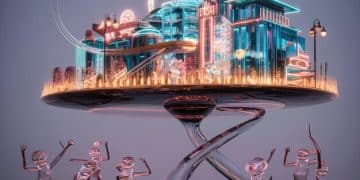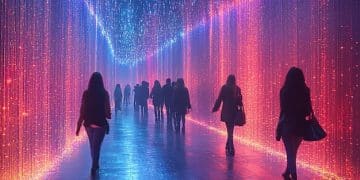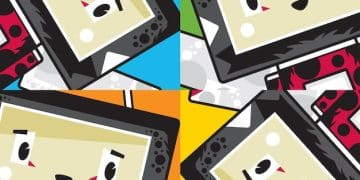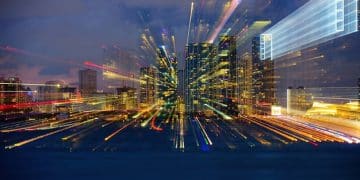The Power of Fandom: Exploring Pop Culture Communities
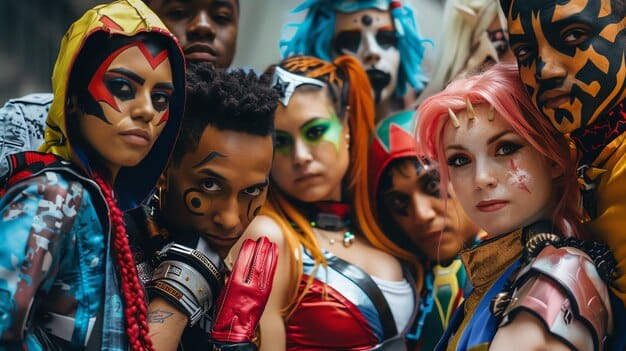
Fandom, a vibrant and dynamic social phenomenon, represents the collective passion and shared identity among enthusiasts of specific pop culture elements, fostering unique communities that shape cultural landscapes and individual experiences globally.
In an increasingly interconnected world, where digital landscapes blur geographical boundaries, communities formed around shared passions have blossomed into powerful social forces. Among these, The Power of Fandom: Exploring Pop Culture Communities stands out as a fascinating and deeply impactful phenomenon. What truly drives this collective devotion, and how do these vibrant communities shape not only individual lives but also the broader cultural narrative? This article delves into the intricate dynamics, unique contributions, and enduring legacy of fandoms across various pop culture realms.
The Genesis of Fandom: From Niche to Mainstream
The concept of fandom is not new, but its evolution from niche gatherings to a pervasive cultural force is remarkable. Historically, enthusiasts of literature, classical music, or sports formed loose associations. However, with the advent of mass media—radio, cinema, and eventually television—the potential for widespread, shared appreciation escalated dramatically. Early science fiction and comic book readers, often considered the progenitors of modern fandom, established rudimentary fan clubs and fanzines, laying the groundwork for today’s intricate networks.
The digital age, more than any other factor, has propelled fandom into the mainstream. Websites, forums, and social media platforms have dismantled geographical barriers, allowing fans to connect instantaneously, share insights, and collectively celebrate their passions. This accessibility has transformed what was once a geographically constrained subculture into a global phenomenon, influencing everything from entertainment production to social discourse.
Defining Fandom: More Than Just Liking Something
At its core, fandom is characterized by an intense, often emotional, engagement with a particular cultural product—be it a book series, a film franchise, a musical artist, a video game, or even a nuanced philosophical concept within a fictional universe. This engagement transcends passive consumption; it involves active participation, speculation, creative expression, and a sense of belonging to a collective with similar interests.
- Shared Identity: Fans often derive a sense of personal identity and self-expression from their chosen fandom, using it as a lens through which they view and interact with the world.
- Emotional Investment: The connection is deeply emotional, leading to strong feelings of pride, excitement, loyalty, and even grief or disappointment in response to narrative developments.
- Active Participation: Beyond consuming content, fans engage through discussions, fan art, fan fiction, cosplay, online forums, and real-world conventions, actively contributing to the cultural ecosystem.
This dynamic relationship between creators and consumers, propelled by the digital landscape, has fundamentally shifted the power balance in pop culture. Fans are no longer mere spectators; they are active co-creators, critics, and evangelists, wielding significant influence over the longevity and direction of their beloved franchises.
The Social Fabric of Fandom: Building Communities and Connections
One of the most potent aspects of fandom is its capacity to forge strong, often lifelong, social connections. In a world that can feel isolating, fandoms offer a haven where individuals can find like-minded peers, share their deepest enthusiasms without judgment, and experience a profound sense of belonging. These communities provide a critical social infrastructure, particularly for those who may feel marginalized in traditional social settings.
The shared passion acts as a powerful adhesive, transcending differences in age, background, geography, and socio-economic status. A convention floor, an online forum, or a fan meetup becomes a neutral ground where people connect through the common language of their chosen pop culture. This creates a unique form of social capital, fostering networks of support, friendship, and collaborative creativity.
Online Hubs: The Digital Agora of Fandom
The internet stands as the primary meeting place for most modern fandoms. Platforms like Reddit, Twitter, Tumblr, Discord, and dedicated fan forums host millions of discussions daily. These online spaces facilitate:
- Instantaneous Connection: Fans can discuss new episodes, theories, and interpretations in real-time, creating a sense of shared experience that amplifies enjoyment.
- Information Exchange: Online hubs centralize knowledge, allowing fans to delve deep into lore, character analyses, and production details, enriching their understanding.
- Collaborative Creativity: Many platforms serve as launching pads for fan-created content, from intricate theories and meta-analyses to fan fiction and interactive role-playing.
The anonymity and accessibility of online platforms also allow individuals to explore aspects of their identity they might otherwise suppress, fostering a sense of liberation and self-acceptance within their fan communities. This often leads to the formation of incredibly close bonds, with online friendships evolving into real-world relationships.
Economic Impact and Industry Influence: The Fan-Driven Market
Fandom is not just a cultural phenomenon; it’s a significant economic driver. The collective purchasing power and intense loyalty of fan bases have a profound impact on the entertainment industry, influencing production decisions, marketing strategies, and merchandising. Studios and creators increasingly recognize that a dedicated fandom can guarantee box office success, album sales, and sustained engagement over decades.
The financial commitment of fans extends beyond ticket and album sales. The market for merchandise—action figures, apparel, collectibles, art books, and more—is enormous, generating billions of dollars annually. This fan-driven economy includes everything from officially licensed products to independent artisan crafts sold at conventions and online marketplaces. The passion of fans directly fuels a vast ecosystem of creators, manufacturers, and retailers.

Fan Activism and Advocacy: Shaping Narratives and Industries
Beyond economic influence, fandoms have demonstrated remarkable power in shaping narratives and advocating for change within the industries they support. Fan campaigns, often organized through social media, have rallied support for endangered shows, influenced casting decisions, prompted reconsiderations of plotlines, and even pushed for greater diversity and representation in media. The “Save The Expanse” movement, which saw fans successfully lobby Amazon to pick up the canceled show, serves as a prominent example of this collective power.
- Consumer Power: Organized fan efforts can significantly impact media projects, demonstrating that their voices are heard and can influence corporate decisions.
- Demand for Representation: Fandoms often champion inclusivity, urging creators to portray diverse characters and narratives that reflect a broader spectrum of human experience.
- Ethical Consumption: Fans are increasingly critical of problematic content or practices within their chosen franchises, using their collective voice to advocate for ethical production and responsible storytelling.
This dynamic has created a feedback loop where creators are more attuned to fan expectations, and fans, in turn, feel a greater sense of ownership and investment in their beloved stories. This symbiotic relationship, while sometimes fraught, ultimately enriches the cultural landscape.
Creative Expression and Artistic Contributions: The Fan-Made Universe
Perhaps one of the most vibrant and underestimated aspects of fandom is its role as a hotbed of creative expression. Dissatisfied with the boundaries of official narratives or simply inspired to expand upon them, fans engage in a vast array of creative endeavors. This fan-made content often rivals professional productions in its complexity, emotional depth, and artistic merit, forming a parallel universe of storytelling and art.
Fan fiction, where fans create original stories using characters and settings from existing franchises, is a cornerstone of this creativity. These stories range from short vignettes to sprawling multi-volume sagas, exploring alternative timelines, focusing on overlooked characters, or delving into emotional complexities that official content might avoid. Similarly, fan art encompasses everything from digital paintings and traditional illustrations to elaborate costumes (cosplay) and meticulously crafted props.
Transformative Works: Remixing and Reinventing
The concept of “transformative works” is central to fan creativity. These are creations that, while based on existing intellectual property, add new meaning, understanding, or aesthetic value. This transformative process allows fans to engage critically with source material, comment on societal norms, or simply explore new narrative possibilities.
- Fan Fiction: Reimagining existing narratives, characters, and settings, often exploring themes or pairings not covered in official lore.
- Fan Art and Cosplay: Visual interpretations and physical embodiments of beloved characters and universes, showcasing immense skill and dedication.
- Fan Videos and Music: Remixes, tributes, and original compositions inspired by the source material, demonstrating diverse artistic talents.
These creative outputs are not merely imitations; they are vital contributions that enrich the entire pop culture ecosystem. They demonstrate the enduring human need to create, interpret, and connect through shared stories, often pushing the boundaries of what official content might explore.
The Psychological and Personal Benefits of Fandom
Beyond the social and economic dimensions, fandom offers significant psychological and personal benefits to its participants. For many, engaging with a beloved franchise provides an escape from daily stressors, a source of comfort, and a means of emotional regulation. The act of immersing oneself in a fictional world can be therapeutic, offering a safe space to process complex emotions or simply to relax and unwind.
Fandoms can also foster personal growth. The process of analyzing narratives, debating theories, or collaborating on fan projects enhances critical thinking, communication skills, and problem-solving abilities. Moreover, the act of creating fan art or writing fan fiction can boost confidence, develop artistic talents, and provide a sense of accomplishment.

Coping Mechanisms and Identity Formation
For some, fandoms serve as crucial coping mechanisms, offering solace during difficult times. The stability and predictability of a beloved fictional world can be comforting in an unpredictable real one. Furthermore, the shared experiences within a fan community can reduce feelings of isolation and provide a sense of validation, especially for individuals who might feel different or misunderstood in other social contexts.
- Stress Relief: Immersion in a fictional world offers an escape and a way to decompress from real-world pressures.
- Emotional Processing: Engaging with characters and narratives can help individuals explore and understand their own emotions in a safe, indirect way.
- Sense of Belonging: Finding others with shared niche interests provides a community where one feels accepted and understood.
The exploration of identity within fandom is also profound. Through cosplay, role-playing, or adopting fan-specific terminology, individuals can experiment with different facets of their personality, developing a stronger sense of self and expressing aspects of who they are that might be otherwise constrained.
Challenges and Criticisms: The Darker Side of Fandom
While the positives of fandom are numerous, it is crucial to acknowledge and address its challenges and criticisms. Not all aspects of fandom are constructive or inclusive. The intensity of fan passion, when misdirected, can lead to negative behaviors, creating environments that are toxic, exclusionary, or even harmful. Understanding these dynamics is essential for fostering healthier and more welcoming communities.
One significant criticism revolves around the phenomenon of “toxic fandom.” This often manifests as aggressive online behavior, harassment of creators or fellow fans who hold differing opinions, and an inability to accept criticism of beloved franchises. This can lead to a hostile environment, driving away new members and silencing dissenting voices. The fervent loyalty that defines fandom can, at times, blind some fans to flaws or problematic elements within their chosen media, leading to fierce defensiveness.
Exclusion and Gatekeeping: Barriers to Entry
Another common issue is gatekeeping, where established fans attempt to control who is “truly” a fan by setting arbitrary criteria for knowledge or devotion. This elitism can alienate newcomers and create a sense of inaccessibility, counteracting the welcoming nature that many fan communities strive for. Similarly, some fandoms struggle with issues of diversity and inclusion, with certain voices or identities being marginalized or unwelcome.
- Toxic Behavior: Online harassment, doxing, and aggressive attacks on creators or other fans who express criticism or differing opinions.
- Gatekeeping: The act of trying to exclude or invalidate someone’s fan status based on perceived lack of knowledge or devotion.
- Creator Burnout: The intense scrutiny and relentless demands from some fan bases can lead to significant stress and burnout for creators.
Addressing these challenges requires ongoing efforts from both community leaders and individual fans. Promoting empathy, encouraging constructive criticism, and actively combating harassment are vital steps toward cultivating spaces that remain positive and inclusive for everyone who wishes to participate in the joyous world of pop culture fandom.
| Key Point | Brief Description |
|---|---|
| 🤝 Community Building | Fandoms foster strong social connections and a sense of shared identity among diverse individuals. |
| 💰 Economic Influence | Fan loyalty and purchasing power significantly impact the entertainment industry and merchandise markets. |
| 🎨 Creative Expression | Fandoms are hubs of fan-made content, including fan fiction, art, and cosplay, enriching cultural output. |
| 🛡️ Challenges & Solutions | Issues like toxicity and gatekeeping require active community efforts for inclusivity and positive engagement. |
Frequently Asked Questions about Fandom
▼
A fandom involves a deeper, more active engagement beyond casual enjoyment. It includes strong emotional investment, participation in discussions, creating or consuming fan-made content, and a sense of belonging to a community of like-minded enthusiasts, actively contributing to the cultural ecosystem of their shared interest.
▼
Digital technology has revolutionized fandom by removing geographical barriers, allowing instantaneous connection and discussion. Platforms like social media and forums enable rapid information exchange, coordinated fan activism, and widespread sharing of creative works, transforming fandom into a global, interconnected phenomenon that influences media production and consumption.
▼
Absolutely. Fandoms possess significant economic and cultural power. Organized fan campaigns can sway production decisions, influence casting, and even save canceled shows. Their collective voice often pushes for greater diversity and representation in media, demonstrating that active fan engagement can directly shape the narratives and ethical practices of the industries they support.
▼
Creative expression within fandoms is incredibly diverse. Popular forms include fan fiction, where fans write original stories using existing characters and settings; fan art, encompassing digital and traditional illustrations; and cosplay, the practice of creating and wearing elaborate costumes depicting characters. These transformative works often add new meaning and value to the source material.
▼
Despite their many benefits, fandoms can face challenges like “toxic fandom,” characterized by aggressive online behavior and harassment. Gatekeeping, where some fans try to exclude others, is also an issue. These negative aspects can create hostile environments, highlighting the importance of fostering inclusive conduct and responsible community management to maintain positive spaces.
Conclusion
The evolving landscape of pop culture fandom encapsulates a profound human need for connection, identity, and shared passion. From its humble origins to its current global influence, fandom demonstrates the remarkable power of collective enthusiasm to shape industries, inspire creativity, and forge lasting bonds. While challenges like toxicity exist, the immense benefits—from fostering community and driving economic impact to providing psychological comfort and a platform for artistic expression—underscore its enduring significance. Understanding the power of fandom: exploring pop culture communities is not just about dissecting a cultural phenomenon; it’s about acknowledging the intricate ways in which our shared stories bring us together, influencing both individual lives and the vast tapestries of modern culture.

